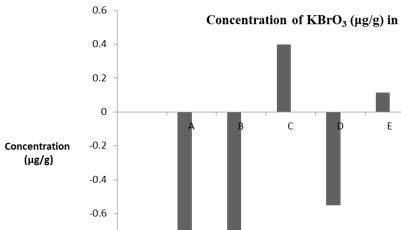Determination of the Presence of Potassium Bromates in Bread Samples Produced in Azare
DOI:
https://doi.org/10.54117/iijbs.v3i1.23Keywords:
Bread samples, potassium bromate, food additives, permissible level, regulatory bodiesAbstract
Introduction/background: To improve bread texture, taste, elasticity of the dough, appearance and sometimes aroma, some ingredients are usually added. However, these ingredients are known to produce adverse health effects over a period of time or if taking in large quantities. One of the commonest food additives is potassium bromate, due to its low cost and being the most efficient oxidizing agent, potassium bromate has been the common choice among bakers and flours millers to raise the dough elasticity and improve texture. Potassium bromate is known to produced reproductive damage, repeated exposure can cause bronchitis, irritability, impaired thinking, personality changes and damage to the kidneys. Larger than recommended quantities should therefore be avoided in processed foods such as bread.
Objectives: The aim of this study was to determine the presence and the level of potassium bromate in some selected bread samples produced in Azare. Azare is the headquarter of Katagum Local government area of Bauchi state Nigeria.
Methods: Bread samples were collected from nine different bakeries that were sited within Azare. And these are the major breads produced and consumed in Azare town and neighboring villages. The bread samples were subjected to both qualitative and quantitative assay to determine the presence and level of the potassium bromate. The qualitative assay was conducted using simple qualitative method where color change (yellow to purple) produces when potassium bromates react with potassium iodide indicate presence of the potassium bromate. While the concentration of the potassium bromate in the bread samples was determine using spectrophotometric analysis measured at 620 nm. The linear regression curve derived from the standard solutions of Potassium bromate was used to calculate the concentration of potassium bromate levels in the bread samples.
Results: The results indicated that bread produced in 5 of the 9 bakeries used in this study contained potassium bromate level within the recommended FDA and NAFDAC permissible level of 0.02ug/g and below. While the remaining four samples contained potassium bromate level higher than the NAFDAC recommended level. Overall, the potassium bromate level across the selected bakeries in this study conducted in Azare town Katagum local government of Bauchi state Nigeria was found in range between -0.91ug/g to 0.40ug/g.
KEYWORDS: Bread samples, potassium bromate, food additives, permissible level, regulatory bodies

Downloads
Published
How to Cite
Issue
Section
License
Copyright (c) 2024 Abbas Ibrahim, Usman A. Garkuwa, Abba M. Usman

This work is licensed under a Creative Commons Attribution 4.0 International License.
